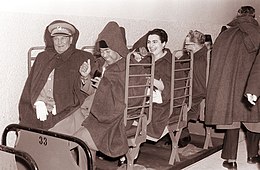Postojna Cave
Postojna Cave (Slovene: Postojnska jama; German: Adelsberger Grotte; Italian: Grotte di Postumia) is a 24.34 km (15.12 mi)[2] long karst cave system near Postojna, southwestern Slovenia.
[5] The cave was first described in the 17th century by the pioneer of study of karst phenomena, Johann Weikhard von Valvasor, although graffiti inside dated to 1213 indicates a much longer history of use.
In the 1850s, the Austrian-Czech geographer Adolf Schmidl published the first comprehensive scientific overview of the Postojna caves and the Pivka Basin, which became a standard reference point in the study of speleology.
[5] During World War II, German occupying forces used the cave to store nearly 1,000 barrels of aircraft fuel, which were destroyed in April 1944 by Slovene Partisans.
The fire burned for seven days, destroying a large section of the cave and blackening the entrance.
However, according to speleology rules, the passages and siphons connecting the caves must be walked or swum through by man for them to be considered one whole.
[22][failed verification] It is the largest permanent exhibition about the cave and karst phenomena around the world.
Children are interactively guided through the exhibition by an olm and a slenderneck beetle, and can ride a cave train by themselves.
